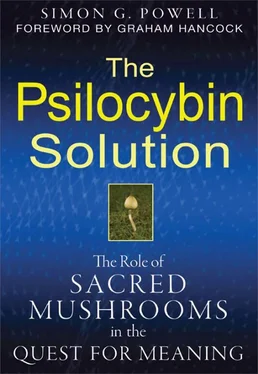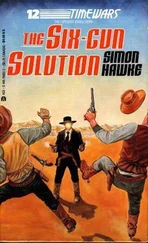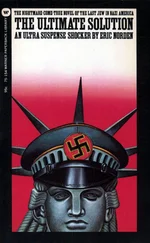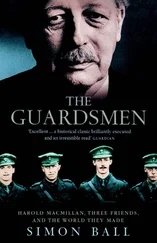Sensing in Pike’s letter that there was indeed some great revelational discovery to be made, the Wassons decided to travel as soon as possible to Huautla, and in 1953 they did so. There could be no mistaking the aroma of the ethnomycological Holy Grail as they neared its living presence. As an aside, they also realized that to judge from Pike’s description, the mushroom being used by these Indians was not the Panaeoleus species previously identified by Schultes. This was further reason for prompt scholarly investigation.
By August 1953 the Wassons had managed to enlist the help of a Mexican curandero, or shaman, and this was an achievement in itself, as the Indians were reluctant to discuss the mushroom with outsiders. Under the pretense of wanting supernaturally inspired news of their son, the Wassons were permitted to take part in a mushroom rite during which the shaman would ingest sacred mushrooms in order to gain the requested information. Unfortunately the shaman was the only person allowed to consume the fungus, and the Wassons were forced to remain uninitiated.
The shaman, under the effects of psilocybin, made three specific predictions concerning the Wassons’ son, which, at the time, he (Wasson) politely humored, as he had no real inkling into psilocybin’s latent ability to produce feats of clairvoyance. His interest was, after all, still predominately academic, and any kind of supernatural utterances were to be taken with a large pinch of salt. As it later transpired, all three of the shaman’s predictions were borne out, and Wasson was at a loss to explain this. Was it coincidence? Or was it a genuine case of the paranormal? Whatever it was, the mysterious mushrooms demanded closer scrutiny, for they seemed to promise much more of interest. Wasson was being drawn ever nearer, as his lifelong adventure drew to an epic climax.
A fully detailed witness account of this mushroom ceremony was to be the culminating chapter of Mushrooms, Russia and History, though just as the book was going to press in June of 1955 a new breakthrough was made. In fact, it was the ultimate breakthrough and became the highlight of R. Gordon Wasson’s scholarly career. It also generated another chapter in his book and the seminal piece for Life magazine. The middle-aged New York banker-turned-ethnomycologist became the first Westerner on record to deliberately consume sacred Mexican mushrooms and behold their entheogenic glory. Wasson had sought, and finally accessed, one of the most remarkable experiences to be had upon this Earth. Thanks to his lifelong persistent efforts, humanity’s exploration of Nature and of the limits of conscious experience became suddenly enhanced as psilocybin made its extraordinary psychedelic presence felt. Indeed, for our purposes, it is rather apt that our man Wasson was provided with an informative and illuminating experience at that time—almost an earthly calling card in fact—as only a few months earlier Nature had consumed the great Einstein. At least it was apt in a relative kind of way for anyone interested in the subtle-yetnever-malicious force of such a wily killer/creator as Nature.
The Mystery Explodes into Life
In telling of his experiences in Life magazine, Wasson comes across as a kind of Prometheus figure, bringing the world news of a hitherto secret gift of the gods. Among dreamy 1950s Technicolor photographs and numerous advertisements for miracle filter cigarettes and various brands of alcohol, Wasson’s article shines like some otherworldly beacon signaling the awesome visionary power latent within the Mexican mushroom. We can only guess at the amazement that this article must have evoked in the psyche of a reader soaked in 1950s thinking and values. This was the decade of Cadillacs, rock ’n’ roll, television, and electronic gadgetry, a decade in which the postwar generation could live happily upon the bountiful fruits of consumerism. Having recently conquered both Everest and the secret of the atom, humankind seemed truly on the ascent. Unlimited atomic energy and unlimited material growth were in the cards. Nature had been tamed and set to work for our own ends.
Of course, what no one realized at this time was the devastating effect upon the environment that an unchecked material culture could wreak. As yet unconceived in holistic organismic terms, the natural environment was a place to take the kids on the weekend, not the grounds for concern, let alone the grounds for a bizarre shamanic consummation. And, after all, weren’t shamans just primitive witch doctors who spouted all sorts of unsophisticated nonsense? It must therefore have been with some surprise that Life’s readers found themselves being informed about visionary fungi, a facet of the environment still wild and untamed and one that spoke of a very different kind of reality from that of the American dream.
Deep in the south of Mexico in a small village in Oaxaca, Wasson recounted to the readers of Life how he had once more gained the confidence of a local shaman, a woman named Maria Sabina, under whose guidance he was allowed to ingest sacred mushrooms. Judging from the photographs included in his account, the house where the ceremony took place was small and sparsely furnished, with various Christian icons on display. The paucity of modern furnishings, however, was in stark contrast to the luxuriousness of the visionary experience that followed the ingestion of the mushrooms, the surroundings all but melting into insignificance.
At 10:30 p.m. Wasson received six pairs of mushrooms from Maria Sabina as she commenced the auspicious rite. At long last he held the elusive mystery in his trembling hands. Tangible and open to physical analysis, the fungi were no native myth or figment of the imagination. But what of their legendary effect? All theory and hearsay became vanquished as Wasson swallowed his destiny.
Like all good empiricists Wasson determined to remain objectively aloof and ward off any major psychological effects so that he could study more clearly the nature of the revered shift in consciousness engendered by the mushroom. As noble as such efforts are, however, they generally prove futile in the face of potent entheogens, as one is forced to wholly succumb to the emergent global alteration in mentation.
As Wasson lay in the dark confines of the hut, the power latent within the mushroom gradually made itself known to him. Visions unfolded before his eyes, visions so intense and so profound that they breached the ineffable realms of religious mysticism. They began as vividly colored art motifs of an angular nature, as found on textiles and carpets. Then the visions evolved into resplendent palaces and gardens laid over with precious stones. At one point, Wasson perceived a great mythological beast drawing a regal chariot. Still later it seemed as if his spirit had broken free from the constraints of his body and lay suspended in midair, viewing vast mountains rising to the Heavens. Wasson confessed that the sights were so sharp and clear as to be more real than anything that he had previously seen with his eyes, somewhat akin to archetypes and the Platonic realm of Ideas.
In Mushrooms, Russia and History, Wasson’s description of his visionary experiences is more explicit than in the Life piece. What had started out as a unique work of ethnomycology, touching on ancient Siberian shamanism, had now transformed into a personal testimony of the mystical experience. Coming from a man normally concerned with the world of finance, this is a truly remarkable turn of events, even more so since he was not overtly religious. It was also the case that any of Wasson’s residual mycophobia had now been utterly obliterated, as the incontrovertible truth of psilocybin-induced shamanic ecstasy seized his soul. The sense of awe, the sense that he had been witness to an event of staggering cultural significance radiates from these more detailed accounts, and the book subsequently ends as a veritable mystical treatise.
Читать дальше










